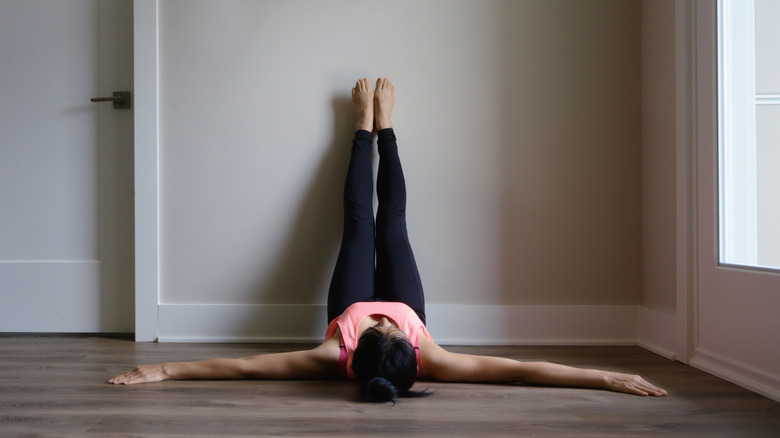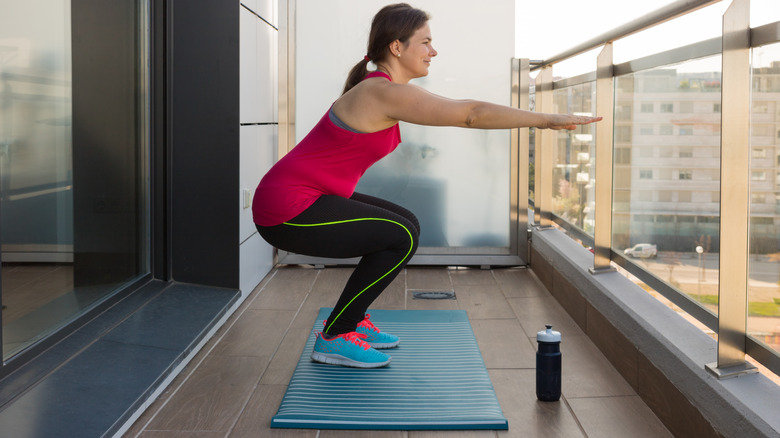Exercises That Can Help Reduce Inflammation
Inflammation in our bodies is one of those topics that can get complicated. That's because our bodies need it to fight sickness and disease, but too much of it can have detrimental effects on our health. Certain factors trigger your body's inflammatory response. For example, smoking, drinking too much alcohol, obesity, chronic stress, and lack of physical activity all have the potential to increase inflammation. Autoimmune diseases and exposure to toxins can also cause inflammation (via Cleveland Clinic). When your immune system is constantly in work mode, it can contribute to several health conditions including asthma, diabetes, arthritis, dementia, and heart disease.
You can help prevent inflammation by maintaining a healthy weight, avoiding smoking, limiting alcohol intake, and learning to manage stress. Avoiding fried foods, highly refined oils and trans fats, cured meat, sugar, and fast foods can also help reduce inflammation. In addition, you can add anti-inflammatory foods like salmon, leafy greens, tomatoes, and olive oil to your diet.
Experts at Cleveland Clinic add that one of the best things you can do to manage inflammation is to exercise at least three to five times per week. The good news is that several forms of exercise can help.
Give yoga a try
Since stress is a primary cause of inflammation, finding a way to eliminate it from your life is a good first step, according to the Cleveland Clinic. One way to do this is with yoga. This ancient practice is about stretching and relaxing the body and calming the mind, two things that naturally reduce tension.
Evidence suggests that it works, too. A 2020 study found that people who practiced Yoga Nidra (a meditative practice) for one month experienced less stress, better sleep, and improved well-being than those who did not. A 2017 study showed that after 38 individuals practiced yoga for three months, researchers saw a reduction in some inflammatory markers (per Harvard Health Publishing). Their routine included performing poses, practicing meditation, and breathing exercises.
Healthline adds that you can reap benefits from performing simple stretches and taking a few minutes to focus on your breathing.
Go for a brisk walk
You probably know that walking has numerous benefits, and you can add fighting inflammation to that list. In fact, a short 20-minute walk may be enough, according to research. A 2017 study showed that 20 minutes of moderate walking on a treadmill produced an anti-inflammatory process by stimulating the immune system (per American Association for the Advancement of Science). Specifically, walking triggers the release of cytokines, which are proteins that regulate inflammation and increase immune responses.
Walking also helps relieve physical and mental stress. When you walk, you release tension that is stored in your muscles. Walking helps lift your mood through the release of endorphins, which help reduce stress (per Verywell Fit). Walking on a treadmill is good, but if you can get outside, that's even better. Harvard Health Publishing explains that being outside gives you a chance to get vitamin D and breathe fresh air. In addition to that, you have time to enjoy the sights and sounds of nature, which can provide a distraction from daily stressors (per University of Minnesota).
Pedal it out
Biking is another way to fight inflammation. You can bike outside or ride a stationary bike indoors. Either way, when you pedal it out, you're giving your immune system a boost, according to The Guardian.
In 2018, researchers studied 125 adults over the age of 55 and found that those who rode a bike experienced a number of benefits including improvement of their immune system. Another study conducted in 2016 showed that 30 minutes of moderate-intensity biking, three times weekly, reduced inflammatory responses among patients with end-stage renal disease.
If you have joint issues, biking is an excellent form of exercise because it is low impact. But there are other benefits, too. Cycling is considered an aerobic exercise, which means it strengthens your heart, lungs, and bones. Regular aerobic exercise also reduces your risk for a host of health conditions including high blood pressure, diabetes, stroke, and some forms of cancer, per the Mayo Clinic.
Work on building muscle
Strength training, or resistance training, is another way to give your immune system a boost. It turns out that muscle mass plays a big part in building a healthy immune system. Your body stores amino acids in muscle, and amino acids help your immune system react swiftly when illness and disease set in. Building and maintaining muscle is important throughout life, but becomes even more important as we age, Dr. Craig Wright of Deakin University's Institute for Physical Activity and Nutrition explains to Sydney Morning Herald.
Research also shows that strength training fights inflammatory responses. According to a 2010 report published in Nutrition Research and Practice, lifting weights seems to reduce inflammation, which can lead to a reduced risk of inflammation-related diseases. Another study, pointing out that exercise has anti-inflammatory effects, explains that strength training — like walking and other forms of exercise — leads to the release of anti-inflammatory cytokines.
Get into bodyweight exercises
Speaking of strength training, you might want to explore bodyweight exercises to help your body reduce inflammation. It may sound intimidating, but bodyweight exercises are not as bad as they sound. One advantage is that you don't need any special equipment to do them. Not only that, but bodyweight exercises are effective. In fact, they are so effective that you don't need to do a lot of them to get results. Defined as "functional" workouts, these types of exercises generally work more than one muscle group, which means you're getting more bang for your buck, according to Harvard Health Publishing.
Bodyweight exercises are a form of strength training, so you're getting the anti-inflammatory effects you would from resistance exercises without dealing with weights (per Livestrong). Examples of bodyweight exercises include push-ups, planks, squats, jumping jacks, lunges, supermans, and shadow boxing. And the best part about bodyweight exercises is that almost every one can be modified for any fitness level (via Verywell Health).






